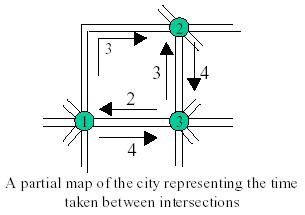poj 1122 FDNY to the Rescue! (最短路+打印路径)
2013-08-08 15:44
218 查看
FDNY to the Rescue!
The Fire Department of New York (FDNY) has always been proud of their response time to fires in New York City, but they want to make their response time even better. To help them with their response time, they want to make sure that the dispatchers know the closest firehouse to any address in the city. You have been hired to write this software and are entrusted with maintaining the proud tradition of FDNY. Conceptually, the software will be given the address of the fire, the locations of the firehouses, street intersections, and the time it takes to cover the distance between each intersection. It will then use this information to calculate how long it takes to reach an address from each firehouse. Given a specific fire location in the city, the software will calculate the time taken from all the fire stations located in the city to reach the fire location. The list of fire stations will be sorted from shortest time to longest time. The dispatcher can then pick the closest firestation with available firefighters and equipment to dispatch to the fire. Input Line 1: # of intersections in the city, a single integer (henceforth referred to as N) N<20 Lines 2 to N+1: A table (square matrix of integer values separated by one or more spaces) representing the time taken in minutes between every pair of intersections in the city. In the sample input shown below the value "3" on the 1st row and the 2nd column represents the time taken from intersection #1 to reach intersection #2. Similarly the value "9" on the 4th row and the 2nd column represents the time taken from intersection #4 to reach intersection #2. A value of -1 for time means that it is not possible to go directly from the origin intersection (row #) to the destination intersection (column #). All other values in the table are non-negative. Line N+2: An integer value n (<= N) indicating the intersection closest to the fire location followed by one or more integer values for the intersections closest to the fire stations (all on one line, separated by one or more spaces) will follow the input matrix. Notes on input format: 1. The rows and columns are numbered from 1 to N. 2. All input values are integers 3. All fire locations are guaranteed reachable from all firehouses. 4. All distance calculations are made from the intersection closest to each firehouse to the intersection closest to the fire. Output Line 1: A label line with the headings for each column, exactly as shown in the example. Line 2 onwards (one line for each fire station): A sorted list (based on time) showing the fire station (origin), the destination site, time taken and a complete shortest path of nodes from the originating fire station to the fire location. Notes on output format: 1. Columns are tab separated. 2. If two or more firehouses are tied in time they can be printed in any order. 3. If more than one path exists that has the same minimal time for a given location & firehouse, either one can be printed on the output. 4. If the fire location and the fire station locations happen to be the same intersection, the output will indicate that the origin and destination have the same intersection number, the time will be "0" and the nodes in the shortest path will show just one number, the fire location. Next is the picture for the sample input data.  Sample Input 6 0 3 4 -1 -1 -1 -1 0 4 5 -1 -1 2 3 0 -1 -1 2 8 9 5 0 1 -1 7 2 1 -1 0 -1 5 -1 4 5 4 0 2 4 5 6 In the above input the last line indicates that "2" is the location of the fire and "4", "5" and "6" are the intersections where fire stations are located. Sample Output Org Dest Time Path 5 2 2 5 2 4 2 3 4 5 2 6 2 6 6 5 2 Source Mid-Atlantic 2001 |
代码:
#include<cstdio>
#include<cstring>
#define maxn 25
#define INF 0x3f3f3f3f
using namespace std ;
int n,m,ans,sx;
bool vis[maxn];
int path[maxn],dist[maxn],ex[maxn];
int city[maxn][maxn];
char s[1005];
void init()
{
memset(dist,0x3f,sizeof(dist));
memset(city,0x3f,sizeof(city));
memset(vis,0,sizeof(vis));
memset(ex,0,sizeof(ex));
}
void output(int k) // 打印路径
{
int i,j;
while(k!=sx)
{
printf("%d\t",k);
k=path[k];
}
printf("%d\n",sx);
}
void disjk()
{
int i,j,mi,k,now=sx;
vis[now]=1;
dist[now]=0;
if(ex[now]) printf("%d\t%d\t0\t%d\n",now,now,now);
for(i=1;i<n;i++)
{
for(j=1;j<=n;j++)
{
if(!vis[j]&&city[j][now]+dist[now]<dist[j])
{
dist[j]=city[j][now]+dist[now];
path[j]=now; // 记录路径
}
}
mi=INF;
for(j=1;j<=n;j++)
{
if(!vis[j]&&dist[j]<mi)
{
mi=dist[j];
k=j;
}
}
now=k;
if(ex[k]) // 是起点就输出
{
printf("%d\t%d\t%d\t",k,sx,dist[k]);
output(k);
}
vis[k]=1;
}
}
void solve() // 读终点和起点
{
int i,j,cnt=0,t=0,flag=0;
for(i=0;s[i]!='\0';i++)
{
if(s[i]>='0'&&s[i]<='9')
{
flag=1;
t=t*10+s[i]-'0';
}
else
{
if(flag)
{
flag=0;
cnt++;
if(cnt>1) ex[t]=1;
else sx=t;
t=0;
}
}
}
if(flag) ex[t]=1;
}
int main()
{
int i,j,t,test=-1;
while(~scanf("%d",&n))
{
test++;
init();
for(i=1;i<=n;i++)
{
for(j=1;j<=n;j++)
{
scanf("%d",&t);
if(i==j) continue ;
if(t>=0) city[i][j]=t;
}
}
gets(s); // 去掉一行的空行
gets(s);
solve();
if(test) printf("\n");
printf("%s\t%s\t%s\t%s\n","Org","Dest","Time","Path");
disjk();
}
return 0;
}
相关文章推荐
- fzu-2261(spfa打印最短路径,求最短路)
- 最短路打印路径SPFA(good)uva11374
- HDU 1385 Minimum Transport Cost(Floyd 最短路 打印路径)
- HDU1224 Free DIY Tour(最短路变形,最长路打印路径,spfa)
- 用BFS找最短路,并打印路径
- HDU 1385 Minimum Transport Cost(最短路,打印字典序路径)
- hdu 1385 Minimum Transport Cost(最短路,floyd打印字典序路径)
- ZOJ3088 Easter Holidays spfa 最长路 最短路 路径打印
- Easter Holidays(二次spfa求最短路、最长路+打印路径)
- BFS(最短路+路径打印) POJ 3984 迷宫问题
- HDU - 1385 Minimum Transport Cost (最短路dijkstra+打印字典序最小路径)
- 最短路打印路径
- hdu 1385 Minimum Transport Cost 最短路 + 打印字典序最小路径
- zoj 3088 Easter Holidays(最长路+最短路+打印路径)
- CCCC 比赛题目集 L1 - 001 紧急救援 【最大点权和 + 打印路径和路径条数 + 最短路】 好题!!!
- HDU 1385 Minimum Transport Cost(最短路,打印字典序路径)
- zoj 3088 Easter Holidays (SPFA 求最长路 最短路 + 打印路径)
- hdu 3790 最短路径问题(多权值的最短路)
- 最长公共子序列打印路径
- hdu FatMouse's Speed(DP)(打印路径)
